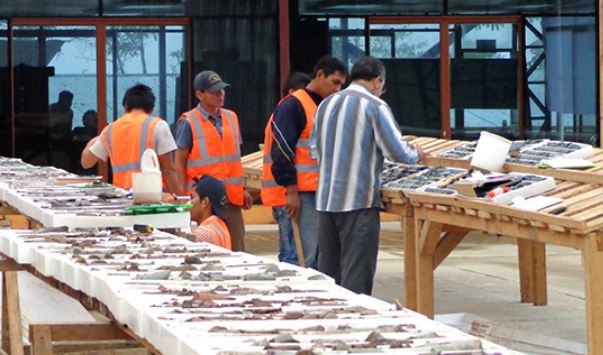Lumina Gold delivers positive Cangrejos PEA

Lumina Gold's diamond drill core facility. Source: Lumina Gold Corp.
Lumina Gold Corp. [LUM-TSXV; LMGDF-OTCQX] has received positive results from the preliminary economic assessment (PEA), prepared in accordance with NI 43-101 standards, for its 100%-owned Cangrejos gold-copper project in southwestern Ecuador. The work that was completed as the basis for the PEA was managed by MTB Enterprises Inc. and demonstrates substantial improvements since the company’s PEA in 2018 with the addition of Gran Bestia, increased mineral resource definition and improved process flow sheet.
Marshall Koval, President and CEO, commented: “I am extremely pleased that we increased the after-tax NPV of Cangrejos by over $600-million to $1.6-billion, maintained average annual gold production of more than 360,000 ounces per year for 25 years and increased the after-tax IRR of the project to 16.2%. Cangrejos is an exceptional global gold deposit and one of the few of this scale that is 100% controlled by an independent developer. Ecuador has made substantial progress in its mining sector with the successful commissioning of Fruta del Norte and Mirador. Now the country will turn their focus to the next generation of development projects.”
The PEA, initiated in late 2019, in US dollars, used base case economics calculated using a gold price of $1,400/oz, a copper price of $2.75/lb, a molybdenum price of $9/lb and a silver price of $16/oz.
The 40,000-tonne-per-day processing operation would be from years 1 to 5, with an expansion to 80,000 tpd in year 6. Average cash operating costs are $545/oz and all-in sustaining costs of $604/oz, net of by-product credits. Life-of-Mine (LOM) processed grades are 0.56 g/t gold and 0.10% copper. LOM revenue mix would be 78.9% gold, 19.4% copper and 1.7% molybdenum plus silver. Initial capital costs including working capital and refundable value-added tax (VAT), of $1-billion. Expansion capital to double throughput including working capital is $454-million.
Gran Bestia material begins to enter the mine production schedule in year 5; however, the majority of the Gran Bestia economic mineralization (88%) is mined in the last nine years of the production schedule.
A 13-month preproduction stripping period, allowing for personnel and equipment ramp-ups, is contemplated to expose sufficient material for initial operations. Haul road construction and clearing and grubbing of the pit area is expected to be performed primarily by contractors prior to the commencement of preproduction stripping.
Refer to company press release for more details.
